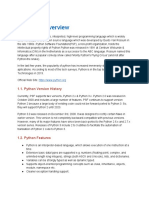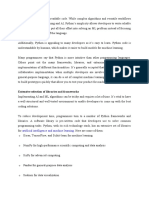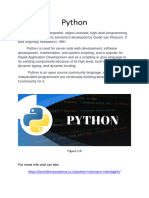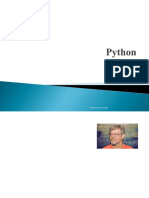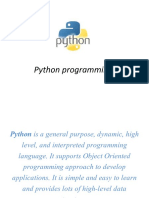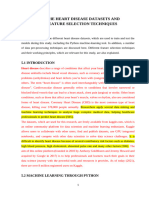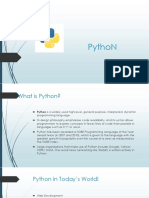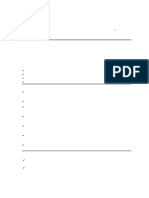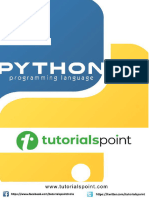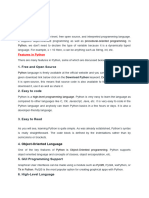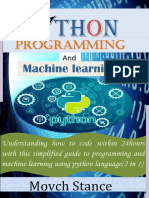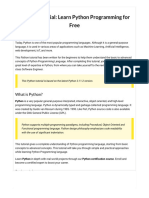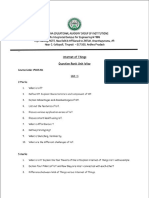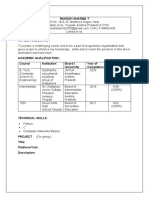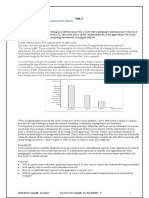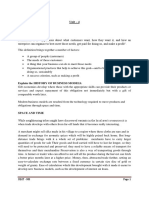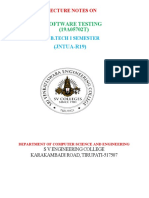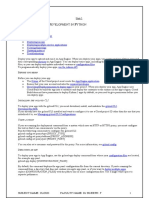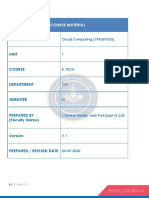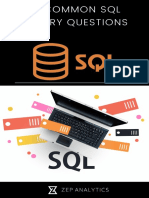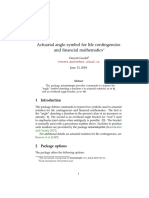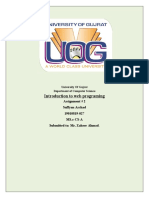CC Unit - 4
CC Unit - 4
Uploaded by
505 DedeepyaCopyright:
Available Formats
CC Unit - 4
CC Unit - 4
Uploaded by
505 DedeepyaOriginal Title
Copyright
Available Formats
Share this document
Did you find this document useful?
Is this content inappropriate?
Copyright:
Available Formats
CC Unit - 4
CC Unit - 4
Uploaded by
505 DedeepyaCopyright:
Available Formats
Unit-4
Python for Amazon Web Services:
Python is a programming language that is widely used in web applications, software development, data science, and
machine learning (ML).
Developers use Python because it is efficient and easy to learn and can run on many different platforms.
Python software is free to download, integrates well with all types of systems, and increases development speed.
BENEFITS OF PYTHON
Benefits of Python include:
Developers can easily read and understand a Python program because it has basic, English-like syntax.
Python makes developers more productive because they can write a Python program using fewer lines of code
compared to many other languages.
Python has a large standard library that contains reusable codes for almost any task. As a result, developers do
not have to write code from scratch.
Developers can easily use Python with other popular programming languages such as Java, C, and C++.
The active Python community includes millions of supportive developers around the globe. If you face an issue,
you can get quick support from the community.
Plenty of helpful resources are available on the internet if you want to learn Python. For example, you can easily
find videos, tutorials, documentation, and developer guides.
Python is portable across different computer operating systems such as Windows, macOS, Linux, and Unix.
PYTHON USED
The Python language has several use cases in application development, including the following examples:
S ERVER-SIDE WEB DEVELOPMENT
Server-side web development includes the complex backend functions that websites perform to display information to the
user. For example, websites must interact with databases, talk to other websites, and protect data when sending it over the
network.
Python is useful for writing server-side code because it offers many libraries that consist of prewritten code for complex
backend functions. Developers also use a wide range of Python frameworks that provide all the necessary tools to build
web applications faster and more easily. For example, developers can create the skeleton web application in seconds
because they don’t need to write it from scratch. They can then test it using the framework’s testing tools, without
depending on external testing tools.
A UTOMATION WITH PYTHON SCRIPTS
A scripting language is a programming language that automates tasks that humans normally perform. Programmers
widely use Python scripts to automate many day-to-day tasks such as the following:
Renaming a large number of files at once
Converting a file to another file type
Removing duplicate words in a text file
Performing basic mathematical operations
Sending email messages
Downloading content
Performing basic log analysis
Finding errors in multiple files
DATA SCIENCE AND MACHINE LEARNING
Data science is extracting valuable knowledge from data, and machine learning (ML) teaches computers to automatically
learn from the data and make accurate predictions. Data scientists use Python for data science tasks such as the following:
Fixing and removing incorrect data, which is known as data cleaning
Extracting and selecting various features of data
Data labeling, which is adding meaningful names for the data
Finding different statistics from data
Visualizing data by using charts and graphs such as line charts, bar graphs, histograms, and pie charts
SUBJECT NAME: CLOUD FACULTY NAME: Dr SUJEETH .T 1
Data scientists use Python ML libraries to train ML models and build classifiers that accurately classify data. People in
different fields use Python-based classifiers to do classification tasks such as image, text, and network traffic
classification; speech recognition; and facial recognition. Data scientists also use Python for deep learning, an advanced
ML technique.
S OFTWARE DEVELOPMENT
Software developers often use Python for different development tasks and software applications such as the following:
Keeping track of bugs in the software code
Automatically building the software
Handling software project management
Developing software prototypes
Developing desktop applications using Graphical User Interface (GUI) libraries
Developing simple text-based games to more complex video games
S OFTWARE TEST AUTOMATION
Software testing is the process of checking whether the actual results from the software match the expected results to
ensure that the software is error-free.
Developers use Python unit test frameworks, such as Unittest, Robot, and PyUnit, to test the functions they write.
Software testers use Python to write test cases for various test scenarios. For example, they use it to test the user
interface of a web application, multiple software components, and new features.
Developers can use several tools to automatically run test scripts. These tools are known as Continuous
Integration/Continuous Deployment (CI/CD) tools. Software testers and developers use CI/CD tools such as Travis CI
and Jenkins to automate tests. The CI/CD tool automatically runs the Python test scripts and reports the test results
whenever developers introduce new code changes.
HISTORY OF PYTHON
Guido Van Rossum, a computer programmer in the Netherlands, created Python. He started it in 1989 at Centrum
Wiskunde & Informatica (CWI), initially as a hobby project to stay busy during Christmastime. The name for the
language was inspired by the BBC TV show Monty Python’s Flying Circus because Guido Van Rossum was a big fan of
the show.
HISTORY OF P YTHON RELEASES
Guido Van Rossum published the first version of the Python code (version 0.9.0) in 1991. It already included good
features such as some data types and functions for error handling.
Python 1.0 was released in 1994 with new functions to easily process a list of data, such as map, filter, and reduce.
Python 2.0 was released on October 16, 2000, with new useful features for programmers, such as support for
Unicode characters and a shorter way to loop through a list.
On December 3, 2008, Python 3.0 was released. It included features such as the print function and more support for
number division and error handling.
FEATURES OF PYTHON
Following features of the Python programming language make it unique:
A N INTERPRETED LANGUAGE
Python is an interpreted language, which means it directly runs the code line by line. If there are errors in the program
code, it will stop running. Therefore, programmers can quickly find errors in the code.
A N EASY-TO -USE LANGUAGE
Python uses English-like words. Unlike other programming languages, Python doesn’t use curly brackets. Instead, it uses
indentation.
A DYNAMICALLY TYPED LANGUAGE
Programmers do not have to declare variable types when writing code because Python determines them at runtime.
Because of this, you can write Python programs more quickly.
A HIGH-LEVEL LANGUAGE
Python is closer to human languages than some other programming languages. Therefore, programmers do not have to
worry about its underlying functionalities such as architecture and memory management.
A N OBJECT-ORIENTED LANGUAGE
SUBJECT NAME: CLOUD FACULTY NAME: Dr SUJEETH .T 2
Python considers everything to be an object, but it also supports other types of programming such as structured and
functional programming.
PYTHON LIBRARIES
A library is a collection of frequently used codes that developers can include in their Python programs to avoid writing
code from scratch. By default, Python comes with the Standard Library, which contains a lot of reusable functions. In
addition, more than 137,000 Python libraries are available for various applications, including web development, data
science, and machine learning (ML).
POPULAR P YTHON LIBRARIES
Matplotlib
Developers use Matplotlib to plot data in high-quality two- and three-dimensional (2D and 3D) graphics. It is often used
in scientific applications. With Matplotlib, you can visualize data by displaying it in different charts such as bar charts
and line charts. You can also plot multiple charts at once, and the graphics are portable across all platforms.
Pandas
Pandas provides optimized and flexible data structures that you can use to manipulate time-series data and structured
data, such as tables and arrays. For example, you can use Pandas to read, write, merge, filter, and group data. Many
people use it for data science, data analysis, and ML tasks.
NumPy
NumPy is a popular library that developers use to easily create and manage arrays, manipulate logical shapes, and
perform linear algebra operations. NumPy supports integration with many languages such as C and C++.
Requests
The Requests library provides useful functions that are required for web development. You can use it to send HTTP
requests, add headers, add URL parameters, add data, and perform many more tasks when communicating with web
applications.
OpenCV-Python
OpenCV-Python is a library that developers use to process images for computer vision applications. It provides many
functions for image processing tasks such as reading and writing images simultaneously, building a 3D environment from
a 2D one, and capturing and analyzing images from video.
Keras
Keras is Python's deep neural network library with excellent support for data processing, visualization and much more.
Keras supports many neural networks. It has a modular structure that offers flexibility in writing innovation applications.
PYTHON FRAMEWORKS
A Python framework is a collection of packages and modules. A module is a set of related code, and a package is a set of
modules. Developers can use Python frameworks to build Python applications more quickly because they do not have to
worry about low-level details such as how communications happen in the web application or how Python will make the
program faster. Python has two types of frameworks:
A full-stack framework includes almost everything that is required to build a large application.
A microframework is a basic framework that provides minimal functionalities for building simple Python
applications. It also provides extensions if applications need more sophisticated functions.
THE MOST POPULAR P YTHON FRAMEWORKS
Developers can use multiple Python frameworks to make their development efficient, including the following
frameworks:
Django
Django is one of the most widely used full-stack Python web frameworks for developing large-scale web applications. It
provides several useful features, including a web server for development and testing, a template engine to build the
website frontend, and various security mechanisms.
Flask
Flask is a micro-framework for developing small web applications. Its features include strong community support, well-
written documentation, a template engine, unit testing, and a built-in web server. It also provides extensions for validation
support, database mapping layers, and web security.
TurboGears
TurboGears is a framework designed to build web applications faster and easier. These are some of its popular features:
A specific database table structure
Tools for creating and managing projects
SUBJECT NAME: CLOUD FACULTY NAME: Dr SUJEETH .T 3
A template engine to build the databases
A template engine to build the frontend
Mechanisms to handle web security
Apache MXNet
Apache MXNet is a fast, flexible, and scalable deep learning framework that developers use to build research prototypes
and deep learning applications. It supports multiple programming languages, including Java, C++, R, and Perl. It
provides a rich set of tools and libraries to support development. For example, you can find an interactive machine
learning (ML) book, computer vision toolkits, and deep learning models for Natural Language Processing (NLP), which
processes natural language such as text and speech.
PyTorch
PyTorch is a framework for ML that has been built on top of the Torch library, which is another open-source ML library.
Developers use it for applications such as NLP, robotics, and computer vision, finding meaningful information in images
and videos. They also use it to run those applications in CPUs and GPUs.
PYTHON IDES?
An integrated development environment (IDE) is software that gives developers the tools they need to write, edit, test,
and debug code in one place.
THE MOST POPULAR P YTHON IDES ?
PyCharm
JetBrains, a Czech company that develops software tools, created PyCharm. It has a free community edition that is
suitable for small Python applications and a paid professional edition that is suitable for building large-scale Python
applications, with the following full set of features:
Automatic code completion and code inspection
Error handling and quick fixes
Code cleaning without changing the functionality
Support for web application frameworks such as Django and Flask
Support for other programming languages, such as JavaScript, CoffeeScript, TypeScript, AngularJS, and Node
Scientific tools and libraries such as Matplotlib and NumPy
Ability to run, debug, test, and deploy applications in remote virtual machines
A debugger to find errors in the code, a profiler to identify performance issues in the code, and a test runner for
running unit tests
Support for databases
IDLE
Integrated Development and Learning Environment (IDLE) is the Python IDE installed by default. It has been developed
only with Python using the Tkinter GUI toolkit and offers the following features:
Works across many operating systems such as Windows, Unix, and macOS
Provides a shell window to run commands and display the output
Offers a multiple-window text editor that provides code syntax highlighting and automatic code completion
Has its own debugger
Spyder
Spyder is an open-source IDE that many scientists and data analysts use. It provides a comprehensive development
experience with features for advanced data analysis, data visualization, and debugging. It also includes the following
features:
A rich code editor that supports multiple languages
An interactive IPython console
A basic debugger
Scientific libraries such as Matplotlib, SciPy, and NumPy
Ability to explore variables in the code
Ability to view documentation in real time
Atom
Atom is a free editor developed by GitHub that supports coding in many programming languages, including Python.
Using Atom, developers can directly work with GitHub, the website where you can save your code centrally. Atom offers
the following features:
Ability to use with many operating systems
SUBJECT NAME: CLOUD FACULTY NAME: Dr SUJEETH .T 4
Easy installation or creation of new packages
Faster automatic code completion
Ability to search files and projects
Easy customization of the interface
PYTHON SDKS
A software development kit (SDK) is a collection of software tools that developers can use to create software
applications in a particular language. Most SDKs are specific to different hardware platforms and operating systems.
Python SDKs include many tools such as libraries, code samples, and developer guides that developers find helpful when
writing applications.
BOTO3 IN PYTHON
Boto3 is the AWS SDK for Python. You can use it to create, configure, and manage AWS services such as Amazon
Elastic Compute Cloud (EC2), Amazon Simple Storage Service (S3), and Amazon DynamoDB. Boto3 also provides two
types of APIs: low-level APIs and Resource APIs for developers.
AWS PYCHARM
The AWS Toolkit for PyCharm is the plug-in for the PyCharm IDE that makes it easier to create, debug, and deploy
Python applications on AWS. Using the AWS Toolkit for PyCharm, developers can easily get started with Python
development. It provides several useful features for developers, including start guides, step-through debugging, and IDE
deployment.
P YTHON FOR AWS CLOUD9
How to run Python code in an AWS Cloud9 development environment.
RESULT IN CHARGES TO YOUR AWS ACCOUNT . THESE INCLUDE POSSIBLE CHARGES FOR SERVICES SUCH AS
AMAZON ELASTIC COMPUTE CLOUD (A MAZON EC2) AND AMAZON SIMPLE STORAGE SERVICE (AMAZON S3). F OR
MORE INFORMATION , SEE A MAZON EC2 P RICING AND A MAZON S3 P RICING .
PREREQUISITES
Before you use this tutorial, be sure to meet the following requirements.
You have an AWS Cloud9 EC2 development environment
This tutorial assumes that you have an EC2 environment, and that the environment is connected to an Amazon EC2
instance running Amazon Linux or Ubuntu Server. See Creating an EC2 Environment for details.
If you have a different type of environment or operating system, you might need to adapt this tutorial's instructions.
You have opened the AWS Cloud9 IDE for that environment
When you open an environment, AWS Cloud9 opens the IDE for that environment in your web browser. See Opening an
environment in AWS Cloud9 for details.
STEP 1: INSTALL PYTHON
1. In a terminal session in the AWS Cloud9 IDE, confirm whether Python is already installed by running the python3 --
version command. (To start a new terminal session, on the menu bar choose Window, New Terminal.) If Python is
installed, skip ahead to Step 2: Add code.
2. Run the yum update (for Amazon Linux) or apt update (for Ubuntu Server) command to help ensure the latest security
updates and bug fixes are installed.
For Amazon Linux:
sudo yum -y update
For Ubuntu Server:
sudo apt update
3. Install Python by running the install command.
For Amazon Linux:
SUBJECT NAME: CLOUD FACULTY NAME: Dr SUJEETH .T 5
sudo yum -y install python3
For Ubuntu Server:
sudo apt-get install python3
STEP 2: ADD CODE
In the AWS Cloud9 IDE, create a file with the following content and save the file with the name hello.py. (To create a
file, on the menu bar choose File, New File. To save the file, choose File, Save.)
STEP 3: RUN THE CODE
1. In the AWS Cloud9 IDE, on the menu bar choose Run, Run Configurations, New Run Configuration.
2. On the [New] - Stopped tab, enter hello.py 5 9 for Command. In the code, 5 represents sys.argv[1],
and 9 represents sys.argv[2].
3. Choose Run and compare your output.
4. Hello, World!
5. The sum of 2 and 3 is 5.
The sum of 5 and 9 is 14.
6. By default, AWS Cloud9 automatically selects a runner for your code. To change the runner, choose Runner, and then
choose Python 2 or Python 3.
STEP 4: INSTALL AND CONFIGURE THE AWS SDK FOR PYTHON (BOTO3)
The AWS SDK for Python (Boto3) enables you to use Python code to interact with AWS services like Amazon S3. For
example, you can use the SDK to create an Amazon S3 bucket, list your available buckets, and then delete the bucket you
just created.
INSTALL PIP
In the AWS Cloud9 IDE, confirm whether pip is already installed for the active version of Python by running the python
-m pip --version command. If pip is installed, skip to the next section.
To install pip, run the following commands. Because sudo is in a different environment from your user, you must specify
the version of Python to use if it differs from the current aliased version.
INSTALL THE AWS SDK FOR P YTHON (B OTO 3)
After you install pip, install the AWS SDK for Python (Boto3) by running the pip install command.
S ET UP CREDENTIALS IN YOUR ENVIRONMENT
Each time you use the AWS SDK for Python (Boto3) to call an AWS service, you must provide a set of credentials with
the call. These credentials determine whether the SDK has the necessary permissions to make the call. If the credentials
don't cover the necessary permissions, the call fails.
To store your credentials within the environment, follow the instructions in Calling AWS services from an environment
in AWS Cloud9, and then return to this topic.
For additional information, see Credentials in the AWS SDK for Python (Boto3).
STEP 5: ADD AWS SDK CODE
Add code that uses Amazon S3 to create a bucket, list your available buckets, and optionally delete the bucket you just
created.
In the AWS Cloud9 IDE, create a file with the following content and save the file with the name s3.py.
STEP 6: RUN THE AWS SDK CODE
1. On the menu bar, choose Run, Run Configurations, New Run Configuration.
2. For Command, enter s3.py my-test-bucket us-west-2, where my-test-bucket is the name of the bucket to create, and us-
west-2 is the ID of the AWS Region where your bucket is created. By default, your bucket is deleted before the script
exits. To keep your bucket, add --keep_bucket to your command. For a list of AWS Region IDs, see Amazon Simple
Storage Service Endpoints and Quotas in the AWS General Reference.
Note:Amazon S3 bucket names must be unique across AWS—not just your AWS account.
3. Choose Run, and compare your output.
STEP 7: CLEAN UP
To prevent ongoing charges to your AWS account after you're done with this tutorial, delete the AWS Cloud9
environment. For instructions, see Deleting an environment in AWS Cloud9.
SUBJECT NAME: CLOUD FACULTY NAME: Dr SUJEETH .T 6
AUTOMATE P YTHON FLASK DEPLOYMENT TO THE AWS CLOUD
introducing additional AWS services that demonstrate how to manage and deploy an application in the AWS Cloud. The
updated workflow includes the following additions: Continuous Integration / Continuous Deployment (CI / CD) pipeline,
applications tests, Blue / Green application deployment pattern, and updated Terraform modules. This additional
functionality enables developers to automatically test and deploy new versions of the Flask application. Using Python
Flask, Terraform, and Docker in conjunction with several AWS services, you configure a CI/CD pipeline for deploying a
Python Flask application.
After going through this exercise, readers will know how to use AWS services and open source tools for managing an
open source application in the AWS Cloud.
PREREQUISITES
An AWS account with local credentials properly configured (typically under ~/.aws/credentials).
The latest version of the AWS Command Line Interface (AWS CLI). For more information, refer to the
documentation for installing, updating, and uninstalling the AWS CLI.
Terraform14.7+ installed on local workstation.
Docker Desktop 3.1.0+ installed on local workstation.
A Git client to clone the source code provided and a GitHub repository.
Python6+ installed on local workstation.
Boto3 installed on local workstation.
SOLUTION OVERVIEW
There is a sample Python Flask application that is deployed by AWS CodePipeline. The pipeline uses Docker to build
and deploy the image to the Amazon Elastic Container Registry (Amazon ECR). Unit tests are run during the Docker
image build. Next, the appspec file is updated to point to the latest ECS task Definition. AWS CodeDeploy kicks off
a Blue / Green deployment and deploys the latest Docker image to Elastic Container Service running on EC2 instances.
Once traffic is shifted to the new version of the application, CodeDeploy completes successfully and the latest version of
the Flask application is running on ECS.
The pipeline deploys the Flask application:
1. The developer pushes code to the main branch.
SUBJECT NAME: CLOUD FACULTY NAME: Dr SUJEETH .T 7
2. An update to the main branch invokes the pipeline.
3. The pipeline clones the AWS CodeCommit repository.
4. Docker builds the container image, runs unit tests, and assigns tags.
5. Docker pushes the image to Amazon ECR.
6. CodeDeploy Blue / Green deployment with the latest version of Flask app deployed to ECS
APPLICATION OVERVIEW
Python Flask is the foundation for the rest API. Python Flask is a micro framework for building web applications. The
Flask application has has a back end database of Amazon DynamoDB. The Flask API defines two routes. The first route
maps to /, and the second maps to /v1/bestmusic/90s/artist. These are the only paths recognized by the application. If you
enter any other URL when accessing the API, you will receive an error message. You can define specific error responses
in the API routes. For example, referencing the Python functions in the get_artist method, “Artist does not exist” is
the response returned when a users requests an artist that is not present in the DynamoDB table (musicTable).
The create_artist method posts an artist and song to your DynamoDB.
Unit and functional tests are also included as part of this workflow. PyUnit is used for the unit tests. The below diagram
depicts the application architecture.
You now configure and deploy the AWS services:
1. Clone the demo code:
git clone https://github.com/aws-samples/deploy-python-flask-microservices-to-aws-using-open-source-tools-part2
2. Change directory into the terraform/ directory:
cd terraform/
3. Create the CodeCommit repository:
make configure-repo
You should see output similar to the following:
INFO: Creating CodeCommit repository.
{ repositoryMetadata: { accountId: 01234567890, repositoryId: 1b807cbf-c184-4e9c-823b-3262973b39cc,
repositoryName: FlaskDemoRepo-01234567890, repositoryDescription: Flask demo application repo.,
lastModifiedDate: 2022-05-12T11:40:09.129000-04:00, creationDate: 2022-05-12T11:40:09.129000-04:00,
cloneUrlHttp: https://git-codecommit.us-east-1.amazonaws.com/v1/repos/FlaskDemoRepo-01234567890,
cloneUrlSsh: ssh://git-codecommit.us-east-1.amazonaws.com/v1/repos/FlaskDemoRepo-01234567890, Arn:
arn:aws:codecommit:us-east-1:1234567890:FlaskDemoRepo-01234567890 } }
INFO: Successfully created CodeCommit repository.
INFO: The CodeCommit HTTP clone URL is
https://git-codecommit.us-east-1.amazonaws.com/v1/repos/FlaskDemoRepo-01234567890
4. Clone the AWS CodeCommit repository, you may be prompted for your CodeCommit username / password:
SUBJECT NAME: CLOUD FACULTY NAME: Dr SUJEETH .T 8
make clone
The output should look like the following:
Cloning into 'FlaskDemoRepo-01234567890-'...
warning: You appear to have cloned an empty repository.
5. Configure the CodeCommit repository:
make upload-codecommit
The output should look like the following:
cd /home/ssm-user/private-rest-api/terraform/FlaskDemoRepo-01234567890 && \
git checkout -b main && \
cd /home/ssm-user/private-rest-api && \
tar czf demo-code.tar.gz app Dockerfile appspec.yaml buildspec.yml && \
tar -tvf demo-code.tar.gz && \
mv /home/ssm-user/private-rest-api/demo-code.tar.gz /home/ssm-user/private-rest-api/terraform/FlaskDemoRepo-
01234567890 && \
cd /home/ssm-user/private-rest-api/terraform/FlaskDemoRepo-01234567890 && \
tar -xvf /home/ssm-user/private-rest-api/terraform/FlaskDemoRepo-01234567890/demo-code.tar.gz && \
rm /home/ssm-user/private-rest-api/terraform/FlaskDemoRepo-01234567890/demo-code.tar.gz && \
git add . && \
git commit -m "Configuring repo." && \
git push -u origin main
Switched to a new branch 'main'
drwxr-xr-x ssm-user/ssm-user 0 2022-07-13 00:47 app/
drwxr-xr-x ssm-user/ssm-user 0 2022-07-13 00:47 app/tests/
drwxr-xr-x ssm-user/ssm-user 0 2022-07-12 19:25 app/tests/lambda-tests/
-rw-r--r-- ssm-user/ssm-user 1970 2022-07-12 19:25 app/tests/lambda-tests/functional_test.py
-rw-r--r-- ssm-user/ssm-user 918 2022-07-12 19:25 app/tests/lambda-tests/functional_test.zip
-rw-r--r-- ssm-user/ssm-user 194 2022-07-13 00:47 app/tests/test.py
-rw-r--r-- ssm-user/ssm-user 1319 2022-07-13 00:47 app/app.py
-rw-r--r-- ssm-user/ssm-user 399 2022-07-12 19:25 Dockerfile
-rw-r--r-- ssm-user/ssm-user 291 2022-07-12 19:25 appspec.yaml
-rw-r--r-- ssm-user/ssm-user 957 2022-07-12 19:25 buildspec.yml
app/
app/tests/
app/tests/lambda-tests/
app/tests/lambda-tests/functional_test.py
app/tests/lambda-tests/functional_test.zip
app/tests/test.py
app/app.py
Dockerfile
appspec.yaml
buildspec.yml
[main (root-commit) 3e37158] Configuring repo.
7 files changed, 179 insertions(+)
create mode 100644 Dockerfile
create mode 100644 app/app.py
create mode 100644 app/tests/lambda-tests/functional_test.py
create mode 100644 app/tests/lambda-tests/functional_test.zip
create mode 100644 app/tests/test.py
create mode 100644 appspec.yaml
create mode 100644 buildspec.yml
Username for 'https://git-codecommit.us-east-1.amazonaws.com': awsjoe-at-01234567890
Password for 'https://awsjoe-at-01234567890@git-codecommit.us-east-1.amazonaws.com':
Enumerating objects: 12, done.
Counting objects: 100% (12/12), done.
Delta compression using up to 2 threads
Compressing objects: 100% (12/12), done.
Writing objects: 100% (12/12), 3.73 KiB | 3.73 MiB/s, done.
Total 12 (delta 0), reused 0 (delta 0), pack-reused 0
To https://git-codecommit.us-east-1.amazonaws.com/v1/repos/FlaskDemoRepo-01234567890
SUBJECT NAME: CLOUD FACULTY NAME: Dr SUJEETH .T 9
* [new branch] main -> main
Branch 'main' set up to track remote branch 'main' from 'origin'.
6. Deploy the AWS Services:
make deploy-infra
This will result in great deal of output ending in:
Apply complete! Resources: 118 added, 1 changed, 0 destroyed.
Outputs:
aws_lb_dns_name = "ecsalb-123456789.us-east-1.elb.amazonaws.com"
7. In the AWS Console open CodePipeline → Pipelines and select flask-demo-pipeline:
8. Scroll down to the Deploy phase and click Details:
9. Wait for the deployment to complete, it should take around 8 minutes:
SUBJECT NAME: CLOUD FACULTY NAME: Dr SUJEETH .T 10
10. Back in your terminal, run the following command to list the Terraform outputs:
terraform output
You should see output similar to the following:
aws_lb_dns_name = "ecsalb-123456789.us-east-1.elb.amazonaws.com"
11. Run the following command using the aws_lb_dns_name from the previous step to test that the application is
functioning properly:
curl http://ecsalb-123456789.us-east-1.elb.amazonaws.com/
You should see output similar to the following:
Hello World!
PYTHON APP DEVELOPMENT ON GOOGLE CLOUD PLATFORM (GCP)
Google Cloud Platform supports Python 3. If you are a python developer and you are still new in Google Cloud Platform,
this article will guide you step by step. Please keep on reading
Knowing the basics Google Cloud Platform
Google Cloud Console, Cloud Shell, Google Command Line, Google Editor, Virtual Machine Instance, Google Compute
Engine, Google API.
Google Cloud Console: An interface basis on the web to run the google cloud platform.
Console Google Cloud Platform
SUBJECT NAME: CLOUD FACULTY NAME: Dr SUJEETH .T 11
Cloud Shell: a Debian-based virtual machine and as the terminal environment for you to manage GCP projects and
resources easily by typing the google command line.
Google Command Line
You can utilize this instrument to perform numerous platform tasks in scripts, or command lines, or another automation.
Reference :
https://cloud.google.com/sdk/gcloud/reference and https://cloud.google.com/sdk/docs/cheatsheet
Google Cloud Editor
https://cloud.google.com/shell/docs/viewing-and-editing-files
Virtual Machine Instance
A virtualized operating system or application environment to implement software in the cloud system that can be run on
Google infrastructure.
Google Compute Engine
A Google service on the google cloud platform permits clients to dispatch virtual machines on request.
Google API
This tool is the way for you to interact on the Google Cloud Platform by enabling the APIs and Services on the google
cloud console
Set Up Python Environment
Prepare the Python environment for your local machine
Install the latest version of Python.
Use venv to isolate dependencies.
Install an editor (optional): Sublime Text, Atom, Pycharm
Install the Cloud SDK (optional).
Install the Cloud Client Libraries for Python (optional).
Install other useful tools.
Step by step to Run App Dev with python on GCP
You must have an account on the GCP first. You should register for a new account if you are a new GCP user. If you
already had it, log in to your GCP account.
Login to GCP Account
SUBJECT NAME: CLOUD FACULTY NAME: Dr SUJEETH .T 12
Welcome To GCP Account
After that, You need to create the virtual machine instance with google compute engine first.
Here are the steps to create VM instance on Google Console :
Console Google Cloud Platform
1. On the Google Cloud Console, Choose Compute Engine, VM Instance then click create
2. Create the instance: Type The name, select the Region and the Zone
3. Allow full access to all Cloud APIs in the Identity and API section.
4. Enable Allow HTTP traffic in the firewall.
5. Create
SUBJECT NAME: CLOUD FACULTY NAME: Dr SUJEETH .T 13
Create VM Instance on GCP
6. Click The instance you just created on the VM instance page
7. Click SSH to open the browser window
SUBJECT NAME: CLOUD FACULTY NAME: Dr SUJEETH .T 14
VM Instance Page
Still in SSH Window, Now Install Software.
SSH Window
Here is a step by step guidance for you:
1. Update The Debian Package list: Sudo apt-get update
2. Install Git: Sudo apt-get install git
3. Install python :
sudo apt-get install python3-setuptools python3-dev build-essential
4. Install pip
curl https://bootstrap.pypa.io/get-pip.py -o get-pip.py
Sudo python3 get-pip.py
SSH Window
SUBJECT NAME: CLOUD FACULTY NAME: Dr SUJEETH .T 15
Verify Python Installation
1. python3 — version
2. pip3 — version
3. git clone https://github.com/GoogleCloudPlatform/training-data-analyst (This is a sample file from Google Cloud
Platform)
4. cd ~/training-data-analyst/courses/developingapps/python/devenv/
5. sudo python3 server.py
Then Configure your Virtual Machine so you can run the Application
Navigation menu ===> Compute Engine ===> Virtual Instances, and click on the External IP address for the
instance that you just created it before.
1. Return to the SSH window, and stop the application by pressing Ctrl+c.
2. sudo pip3 install -r requirements.txt
3. python3 list-gce-instances.py <PROJECT_ID> — zone=<YOUR_VM_ZONE>
SSH Window
CONTAINERIZED PYTHON WEB APP ON AZURE WITH MONGODB
to containerize a Python web app and deploy it to Azure. The single container web app is hosted in Azure App
Service and uses MongoDB for Azure Cosmos DB to store data. App Service Web App for Containers allows you to
focus on composing your containers without worrying about managing and maintaining an underlying container
orchestrator. When building web apps, Azure App Service is a good option for taking your first steps with containers. For
more information about using containers in Azure, see Comparing Azure container options.
Build and run a Docker container locally. This step is optional.
Build a Docker container image directly in Azure.
Configure an App Service to create a web app based on the Docker container image.
Following this tutorial, you'll have the basis for Continuous Integration (CI) and Continuous Deployment (CD) of a
Python web app to Azure.
SERVICE OVERVIEW
The service diagram supporting this tutorial shows two environments (developer environment and Azure) and the
different Azure services used in the tutorial.
SUBJECT NAME: CLOUD FACULTY NAME: Dr SUJEETH .T 16
The components supporting this tutorial and shown in the diagram above are:
Azure App Service
o The underlying App Service functionality that enables containerization is Web App for Containers. Azure
App Service uses the Docker container technology to host both built-in images and custom images. In this
tutorial, you'll build an image from Python code and deploy it to Web App for Containers.
o Web App for Containers uses a webhook in the registry to get notified of new images. A push of a new image
to the repository triggers App Service to pull the image and restart.
Azure Container Registry
o Azure Container Registry enables you to work with Docker images and its components in Azure. It provides
a registry that's close to your deployments in Azure and that gives you control over access, making it possible
to use your Azure Active Directory groups and permissions.
o In this tutorial, the registry source is Azure Container Registry, but you can also use Docker Hub or a private
registry with minor modifications.
Azure Cosmos DB for MongoDB
o The Azure Cosmos DB for MongoDB is a NoSQL database used in this tutorial to store data.
o Access to Azure Cosmos DB resource is via a connection string, which is passed as an environment variable
to the containerized app.
AUTHENTICATION
In this tutorial, you'll build a Docker image (either locally or directly in Azure) and deploy it to Azure App Service. The
App Service pulls the container image from an Azure Container Registry repository.
The App Service uses managed identity to pull images from Azure Container Registry. Managed identity allows you to
grant permissions to the web app so that it can access other Azure resources without the need to specify credentials.
Specifically, this tutorial uses a system assigned managed identity. Managed identity is configured during setup of App
Service to use a registry container image.
The tutorial sample web app uses MongoDB to store data. The sample code connects to Azure Cosmos DB via a
connection string.
PREREQUISITES
To complete this tutorial, you'll need:
An Azure account where you can create:
o Azure Container Registry
o Azure App Service
SUBJECT NAME: CLOUD FACULTY NAME: Dr SUJEETH .T 17
o MongoDB for Azure Cosmos DB (or access to equivalent). To create an Azure Cosmos DB for MongoDB
database, you can use the steps for Azure portal, Azure CLI, PowerShell, or VS Code. The sample tutorial
requires that you specify a MongoDB connection string, a database name, and a collection name.
Visual Studio Code or Azure CLI, depending on what tool you'll use.
o For Visual Studio Code, you'll need the Docker extension and Azure App Service extension.
Python packages:
o PyMongo for connecting to MongoDB.
o Flask or Django as a web framework.
Docker installed locally if you want to run container locally.
SAMPLE APP
The Python sample app is a restaurant review app that saves restaurant and review data in MongoDB. For an example of
a web app using PostgreSQL, see Deploy a Python web app to Azure with managed identity.
At the end of the tutorial, you'll have a restaurant review app deployed and running in Azure that looks like the
screenshot below.
1. CLONE OR DOWNLOAD THE SAMPLE APP
2. BUILD A DOCKER IMAGE
3. SET UP MONGODB
4. RUN THE IMAGE LOCALLY IN A CONTAINER
Python for MapReduce:
When we deal with “BIG” data, as the name suggests dealing with a large amount of data is a daunting task.MapReduce is
a built-in programming model in Apache Hadoop. It will parallel process your data on the cluster.
This article will look into how MapReduce works with an example dataset using Python.
M APREDUCE: A NALYSE BIG DATA
MapReduce will transform the data using Map by dividing data into key/value pairs, getting the output from a map as an
input, and aggregating data together by Reduce.MapReduce will deal with all your cluster failures.
HOW M APREDUCE WORKS
To understand MapReduce, let’s take a real-world example. You have a dataset that consists of hotel reviews and
ratings. Now you need to find out how many reviews each rating.
SUBJECT NAME: CLOUD FACULTY NAME: Dr SUJEETH .T 18
Dataset Snapshot
So what you will do is you will go through the Rating columns and count how many reviews are there for 1,2,3,4,5. It is
pretty easy to do if we do have a small amount of data but when it comes to big data it can be billions or trillions of data.
Therefore we can use MapReduce.
WHAT’S HAPPENING UNDER THE HOOD
Client node will submit MapReduce Jobs to The resource manager Hadoop YARN.
SUBJECT NAME: CLOUD FACULTY NAME: Dr SUJEETH .T 19
Hadoop YARN resource managing and monitoring the clusters such as keeping track of available capacity of
clusters, available clusters, etc. Hadoop Yarn will copy the needful data Hadoop Distribution File System(HTFS) in
parallel.
Next Node Manager will manage all the MapReduce jobs. MapReduce application master located in Node Manager
will keep track of each of the Map and Reduce tasks and distribute it across the cluster with the help of YARN.
Map and Reduce tasks connect with HDFS cluster to get needful data to process and output data.
L ET’S GET STARTED
MapReduce is written in Java but capable of running g in different languages such as Ruby, Python, and C++. Here we are
going to use Python with the MR job package.
We will count the number of reviews for each rating(1,2,3,4,5) in the dataset.
Step 1: Transform raw data into key/value pairs in parallel.
The mapper will get the data file and make the Rating the key and the values will be the reviews. We will add number 1 for
reviews.
Step 2: Shuffle and short by the MapReduce model.
The process of transferring mappers’ intermediate output to the reducer is known as shuffling. It will collect all the
reviews(number 1s) together with the individual key and it will sort them. it will get sorted by key.
Step3: Process the data using Reduce.
PREREQUISITES
1. Install Python
2. Install Hadoop
3. Install MRJob
pip install mrjoborpython setup.py test && python setup.py install
Here we are having a Job called ‘NoRatings’ consisting of a Mapper function, a Reducer function, and
a definition. A Step function is used to define our functions for mappers and reducers in our job.
Note: Used yield to return statement in a function.
Here is the full code which is saved as NoRatings.py
from mrjob.job import MRJob
from mrjob.step import MRStep
import csv#split by ,
columns = 'Review,Rating'.split(',')class NoRatings(MRJob):
def steps(self):
return[
MRStep(mapper=self.mapper_get_ratings,
reducer=self.reducer_count_ratings)
]
SUBJECT NAME: CLOUD FACULTY NAME: Dr SUJEETH .T 20
#Mapper function
def mapper_get_ratings(self, _, line):
reader = csv.reader([line])
for row in reader:
zipped=zip(columns,row)
diction=dict(zipped)
ratings=diction['Rating']
#outputing as key value pairs
yield ratings, 1#Reducer function
def reducer_count_ratings(self, key, values):
yield key, sum(values)if __name__ == "__main__":
NoRatings.run()
Verify whether the both dataset(Hotel_Reviews.csv) and the python file(NoRatings.py) are there in the directory.
ls
#or
hadoop fs -ls
Run python script with the mrjob. We can run the NoRatings.py script locally or with Hadoop.
#run locallly
#Hotel_Reviews.csv is the dataset.
#verify whether the both dataset(Hotel_Reviews.csv) and the python file(NoRatings.py) are there in current directory. uing 'ls'
command.python NoRatings.py Hotel_Reviews.csv#run with hadoop#python [python file] -r hadoop --hadoop-streaming-jar
[The_path_of_Hadoop_Streaming_jar] [dataset]python NoRatings.py -r hadoop --hadoop-streaming-jar
/usr/local/hadoop/share/hadoop/tools/lib/hadoop-streaming-2.7.1 jar Hotel_Reviews.csv
CONCLUSION
As you have seen MapReduce is necessary to deal with a large amount of data.
Python Packages of Interest:
top ten most important, useful and ubiquitous Python packages
SUBJECT NAME: CLOUD FACULTY NAME: Dr SUJEETH .T 21
1 NUMPY
You can do basic mathematical operations without any special Python packages. However, if you’re going to do any kind
of complex math, the NumPy package will make your coding life much easier.
NumPy provides tools to help build multi-dimensional arrays and perform calculations on the data stored in them. You
can solve algebraic formulas, perform common statistical operations, and much more.
While NumPy is a valuable Python package for a variety of general-purpose programming tasks, it’s particularly
important if you want to do machine learning, since it provides part of the foundation for libraries like TensorFlow.
2 PENDULUM
If you have at least a little Python programming experience, you probably know that you can use the datetime module to
manage dates and times within an application.
While datetime is great for basic work along these lines, the Pendulum Python package makes it easier to do more
complex coding involving dates and times. It’s more intuitive to work with, and it manages time zones automatically.
Best of all, Pendulum is designed to be a drop-in replacement for datetime. That means you can use it with code you’ve
already written based on datetime. With only a few exceptions, Pendulum will work just as well, without the need to
modify the code, while providing extra features not present in plain-old datetime.
3 PYTHON IMAGING LIBRARY
If your Python application interacts with images in any way, the Python imaging library, also known as PIL or Pillow, is
a Python must-have. It makes it easy to write code that opens, modifies, and saves images in a variety of formats.
If you’re doing more advanced work with images (like image recognition, in which case OpenCV would be a good
package to consider), Pillow won’t cut it on its own. But for basic image importing, manipulation, and exporting, Pillow
is your go-to solution.
4 MOVIEPY
MoviePy is to videos what Pillow is to images. It provides a range of functionality for common tasks associated with
importing, modifying, and exporting video files. It also lets you do things like insert titles into videos or rotate videos 90
degrees (if for some reason you decide you want to do that).
Like Pillow, MoviePy is not intended as a tool for advanced data manipulation. If you’re writing a video editing app,
you’ll probably also need to rely on OpenCV (which can work with videos as well as images) to provide the advanced
functionality that MoviePy lacks. But for most standard tasks involving videos in Python code, MoviePy gets the job
done quite well.
5 REQUESTS
Writing code that sends HTTP requests can be tricky, due in no small part to the fact that HTTP does not exactly format
data in a way that is easy for humans to read.
The Requests Python package (motto: “HTTP for Humans”) tackles this problem by automating many of the tedious
tasks that you would otherwise need to perform in order to send HTTP requests from your application. It removes the
need to add query strings, or do POST form encoding. It also keeps connections with HTTP servers alive automatically,
eliminating the need to write a bunch of code for doing that.
In short, if your application sends any data over HTTP, Requests is a must-have package.
Recommended Reads
Want to develop a Python app with a Graphical User Interface (GUI)? There are a variety of packages designed to help
you do that (indeed, we could make a top ten list of just Python GUI packages). But I think most Python developers
would agree that Tkinter is the most important — and most commonly used — framework for creating GUIs. It binds
Python to the TK GUI toolkit, which works on virtually every modern operating system.
Unless you have a strong preference for a different GUI toolkit, Tkinter is probably the best place to start when creating a
Python GUI.
7 PY Q T
The preceding sentence notwithstanding, PyQT, another Python package for building GUIs, is also a strong contender. It
provides bindings to (you guessed it) the Qt toolkit, which is also cross-platform. It’s intended for heavier-duty GUI
programming than Tkinter. That means that PyQT may be overkill if you’re building an app that has a pretty simple
interface — say, just a window with some buttons and text fields — but it is a good tool if you want to build a complex,
multi-dimensional GUI.
Recommended Reads
SUBJECT NAME: CLOUD FACULTY NAME: Dr SUJEETH .T 22
There is a long list of Python packages designed for working with complex data sets. But arguably, Pandas is the most
important. Pandas helps you manipulate and analyze large sets of data without having to learn a specialized data-
processing language like R.
Pandas has its limits in that it’s not intended for advanced statistical modelling (in that case, you would want to learn R,
or use a Python package like statsmodels). But if you need to do things like process time-series data or perform statistical
analysis on a data set, Pandas has you covered.
9 PYWIN32
For Windows Python programming in particular, Pywin32 is a must-have package. It provides access to many of the
native Windows API functions, allowing you to do things like interact with the Windows registry, use the Windows
clipboard, and much more.
Pywin32 won’t do you much good if you’re building a cross-platform Python app, but Windows developers might find
that they like it so much that they use it instead of native Windows tooling.
10 PYTEST
If you have a Python development project of any complexity, being able to perform testing on new code is essential. The
Pytest package provides a variety of modules to help you do this. Whether it’s a simple unit test or a more complex
functional test, Pytest can help you write it.
PYTHON WEB FRAMEWORK:
Python Web framework is a collection of packages or modules that allow developers to write Web applications or services.
With it, developers don’t need to handle low-level details like protocols, sockets or process/thread management.
Python web framework will help you with:
Interpreting requests (getting form parameters, handling cookies and sessions,..)
Producing responses (presenting data as HTML or in other formats,..)
Storing data persistently (and other things)
Now, let’s look at the most useful and famous Python web framework to help you with Web development.
PYTHON FULL-STACK FRAMEWORKS
A full-stack framework in Python is one which attempts to provide a complete solution for applications. It attempts to
supply components for each layer in the stack.
A. DJANGO
Django Python is a framework for perfectionists with deadlines. With it, you can build better Web apps in much less time,
and in less code. Django is known for how it focusses on automating. It also believes in the DRY (Don’t Repeat Yourself)
principle.
Django was originally developed for content-management systems, but is now used for many kinds of web applications.
This is because of its templating, automatic database generation, DB access layer, and automatic admin interface
generation. It also provides a web server for development use.
Giant companies that use Django Python are- Instagram, Pinterest, Disqus, Mozilla, The Washington Times, and
Bitbucket. In fact, when we think of the terms ‘framework’ and ‘Python’, the first thing that comes to our minds is Django.
Some of its features are-
Django helps developers avoid various common security mistakes.
With this framework, developers can take web applications from concept to launch within hours.
THE USER AUTHENTICATION SYSTEM OF THIS FRAMEWORK PROVIDES A SECURE WAY TO MANAGE USER ACCOUNTS AND
PASSWORDSB . T URBO G EARS
SUBJECT NAME: CLOUD FACULTY NAME: Dr SUJEETH .T 23
Python TurboGears — Python Web Framework
With TurboGears, you can create a database-driven, ready-to-extend application in just a few minutes.
It is an MVC web framework with ORM with real multi-database support and support for horizontal data partitioning. It
also has a widget system to simplify the development of AJAX apps. You may additionally install its template engine
Kajiki.
Learn: How to Install Python on Windows
TurboGears is a microframework and a full-stack solution. It’s PyPI package is called tg.devtools.
C . WEB2 PY
Python Web Framework — Python web2py
With web2py, you can develop, deploy, debug, test, administer the database, and maintain applications via the provided
web interface. It has no configuration files, and you can even run it off a USB drive.
web2py uses the MVC built-in ticketing system to manage errors.
D . C UBIC W EB
CubicWeb is a semantic web application framework that features a query language and a selection+view mechanism. It
also features multiple databases, security, workflows, and reusable components.
E . D JANGO - HOTSAUCE
Django-hotsauce is a general-purpose web toolkit that sits on top of Django and other frameworks. It is an interactive
Pythonic API that will let you create scalable web applications using the WSGI 1.0 spec. It also provides native bindings
for the Schevo DBMS, Durus, ZODB, and Authkit projects.
Learn: 7 Reasons Why Should I Learn Python in 2018
F . G IOTTO
A strict MVC framework that strictly separates Model, View and Controller elements, Giotto makes sure that designers,
Web developers, and sysadmins can work independently. It also includes controller modules that allow you to build
applications on top of the web, irc or the command line.These are all the most popular Python web framework.
G . G ROK
Grok was built on the existing Zope 3 libraries. It aims to provide an easier learning curve, and a more agile development
experience by emphasizing on convention over configuration and DRY (Don’t Repeat Yourself).
H . P YLONS
Python Web Framework — Python Pylons
Pylons is a lightweight Web framework aiming at flexibility and rapid development. With the best ideas from Ruby,
Python, and Perl, it makes for a structured, but extremely flexible Python Web framework. With Pylons, Web development
is fast, flexible, and easy. Pylons is built on top of Paste. But after being merged with Pyramid to form the Pylons project,
it is in maintenance-only status.
I. R EAHL
You can use Reahl to develop web applications in pure Python. However, you may use, customize, or compose widgets in
usual Python code. These widgets portray certain server-side and client-side behaviors.
J . WHEEZY . WEB
Wheezy is a lightweight, high performance, and high concurrency WSGI web framework. Its key features include routing,
model update/validation, authentication/authorization, content caching with dependency, middleware, and more. With
these, we can build modern, efficient web.
K . ZOPE 2
SUBJECT NAME: CLOUD FACULTY NAME: Dr SUJEETH .T 24
Python Web Framework — Python Zope
Zope2 is rightly the granddaddy of Python web frameworks, it has been a family of networks. It is a web framework and a
general-purpose application server. Today, it is primarily used for CMS. We also have Zope3, which is a standalone
framework and a collection of related libraries.
L . TORNADO
Python Web Framework — Tornado
While Tornado isn’t that famous, it is great with non-blocking I/O. You can scale it to handle tens of thousands of open
connections. It makes for a perfect framework for long polling, WebSockets, and other usages needing a continuous
connection. Officially, Tornado only supports Linux and BSD OS (Windows and Mac OS X- only for development).
Tornado finds its origin in the FriendFeed project, which now belongs to Facebook.
NON -FULL -STACK FRAMEWORKS IN PYTHON
A Python non full-stack framework will provide the base application server. This either runs as its own independent
process, upon Apache, or in other environments. Let’s look at the most popular ones.
A . P YTHON B OTTLE
Bottle is a simple and fast microframework that you can use to create small Web applications. It provides request-
dispatching routes with URL-parameter support, templates, key/value databases, and a built-in HTTP server. It also offers
adapters for third-party WSGI/HTTP-server and template engines. This is all in a single file; there are no dependencies
except the Python Standard Library.
B . C HERRY PY
Python Web Framework — Python CherryPy
SUBJECT NAME: CLOUD FACULTY NAME: Dr SUJEETH .T 25
It is a pythonic, object-oriented HTTP framework. A web application powered by CherryPy is a standalone Python
application that embeds its own multi-threaded web server.
In a way, CherryPy is a way between the programmer and the problem. It also supports various web servers like Apache,
IIS, and so. CherryPy will let you launch multiple HTTP servers at once.
C . P YTHON F LASK
Python Web Framework — Python Flask
Like we’ve said before, Flask is a microframework for Python. It includes a built-in development server, and unit-testing
support. It is also fully Unicode-enabled with RESTful request-dispatching and WSGI compliance.
Learn: Python Regular Expressions
Flask will be useful when you want to develop small, simple applications. With it, you can operate your database however
you like- using SQLAlchemy or whatever. A goof Flask example is it is used by LinkedIn and Pinterest.
D . H UG
Python Web Framework — Python Hug
Hug is among the fastest web frameworks for Python. With it, you can build APIs. It supports several API versions,
automatic API documentation, and annotation-powered validation. It is built on top of another JSON framework, Falcon.
E . P YRAMID
Python Web Framework — pyramid-positive
Unlike a few that we discussed so far, Pyramid is a framework for large applications. It is flexible; a Pyramid web
application starts from a single-file module, and evolves into an ambitious project. You can say that it makes real-world
Web application development and deployment more fun, predictable, and productive. Actually, Pyramid is a Pylons
project.
F . A LBATROSS
It is a small, flexible Python toolkit that lets you develop highly stateful Web applications. Albatross deploys to CGI,
FastCGI, and ModPython servers.
G . C IRCUITS
Circuits are much like CherryPy, but is a highly efficient web framework to develop standalone multiprocess applications.
It supports concurrency, asynchronous I/O components, and is event-driven.
H . F ALCON
SUBJECT NAME: CLOUD FACULTY NAME: Dr SUJEETH .T 26
Python Web Framework — Python Falcon
A microframework for small applications, app backends, and higher-level frameworks, Falcon encourages to follow the
concept of REST. It is among the fastest web frameworks for Python and is used by EMC, Hurricane Electric, OpenStack,
Opera Software, Wargaming, and others.
I. G ROWLER
Python Web Framework — Python Growler
Growler is built on top of asyncio, and is inspired by Connect and Express frameworks for Node.js. If you want ORM or
templating, you must install it manually. It handles requests by passing through a middleware chain.
J . MORE PATH
MorePath is a flexible, model-driven web framework. It supports REST and focusses on reusability and extensibility.
K . P YCNIC
Pycnic is among the fastest web frameworks for Python for developing JSON APIs. The framework is object-oriented and
optimized for JSON APIs. It only includes tools for creating Web APIs that leave a lighter footprint.
L . S ANIC
Python Web Framework — Python Sanic
Sanic is a flask-like framework, but it is fast. It supports asynchronous request handlers, and makes code non-blocking and
speedy.
So, this was all about Python Web Framework Tutorial. Hope you like our explanation.
Designing a RESTful Web API:
REST APIs are one of the most common kinds of web services available today. They allow various clients including
browser apps to communicate with a server via the REST API. Therefore, it’s very important to design REST APIs
properly so that we won’t run into problems down the road. We have to take into account security, performance, and ease
of use for API consumers.
Otherwise, we create problems for clients that use our APIs, which isn’t pleasant and detracts people from using our API.
If we don’t follow commonly accepted conventions, then we confuse the maintainers of the API and the clients that use
them since it’s different from what everyone expects.
SUBJECT NAME: CLOUD FACULTY NAME: Dr SUJEETH .T 27
In this article, we’ll look at how to design REST APIs to be easy to understand for anyone consuming them, future-proof,
and secure and fast since they serve data to clients that may be confidential.
Accept and respond with JSON
Use nouns instead of verbs in endpoint paths
Name collections with plural nouns
Nesting resources for hierarchical objects
Handle errors gracefully and return standard error codes
Allow filtering, sorting, and pagination
Maintain Good Security Practices
Cache data to improve performance
Versioning our APIs
WHAT IS A REST API?
A REST API is an application programming interface that conforms to specific architectural constraints, like stateless
communication and cacheable data. It is not a protocol or standard. While REST APIs can be accessed through a number
of communication protocols, most commonly, they are called over HTTPS, so the guidelines below apply to REST API
endpoints that will be called over the internet.
Note: For REST APIs called over the internet, you’ll like want to follow the best practices for REST API authentication.
ACCEPT AND RESPOND WITH JSON
REST APIs should accept JSON for request payload and also send responses to JSON. JSON is the standard for
transferring data. Almost every networked technology can use it: JavaScript has built-in methods to encode and decode
JSON either through the Fetch API or another HTTP client. Server-side technologies have libraries that can decode JSON
without doing much work.
There are other ways to transfer data. XML isn’t widely supported by frameworks without transforming the data
ourselves to something that can be used, and that’s usually JSON. We can’t manipulate this data as easily on the client-
side, especially in browsers. It ends up being a lot of extra work just to do normal data transfer.
Form data is good for sending data, especially if we want to send files. But for text and numbers, we don’t need form data
to transfer those since—with most frameworks—we can transfer JSON by just getting the data from it directly on the
client side. It’s by far the most straightforward to do so.
To make sure that when our REST API app responds with JSON that clients interpret it as such, we should set Content-
Type in the response header to application/json after the request is made. Many server-side app frameworks set the
response header automatically. Some HTTP clients look at the Content-Type response header and parse the data
according to that format.
The only exception is if we’re trying to send and receive files between client and server. Then we need to handle file
responses and send form data from client to server. But that is a topic for another time.
We should also make sure that our endpoints return JSON as a response. Many server-side frameworks have this as a
built-in feature.
USE NOUNS INSTEAD OF VERBS IN ENDPOINT PATHS
We shouldn’t use verbs in our endpoint paths. Instead, we should use the nouns which represent the entity that the
endpoint that we’re retrieving or manipulating as the pathname.
This is because our HTTP request method already has the verb. Having verbs in our API endpoint paths isn’t useful and it
makes it unnecessarily long since it doesn’t convey any new information. The chosen verbs could vary by the developer’s
whim. For instance, some like ‘get’ and some like ‘retrieve’, so it’s just better to let the HTTP GET verb tell us what and
endpoint does.
The action should be indicated by the HTTP request method that we’re making. The most common methods include
GET, POST, PUT, and DELETE.
GET retrieves resources.
POST submits new data to the server.
PUT updates existing data.
DELETE removes data.
SUBJECT NAME: CLOUD FACULTY NAME: Dr SUJEETH .T 28
You might also like
- Digital Twin-The Simulation AspectDocument16 pagesDigital Twin-The Simulation Aspectjwpaprk1100% (4)
- AzureDocument297 pagesAzure505 DedeepyaNo ratings yet
- COM 400 Lesson 1 IntroductionDocument50 pagesCOM 400 Lesson 1 Introductiononsarigomomanyi99No ratings yet
- PythonDocument4 pagesPythonS YuvashriNo ratings yet
- Module-1 Python IntroductionDocument7 pagesModule-1 Python IntroductionKTNNo ratings yet
- I Year Python MaterialDocument136 pagesI Year Python Materialஆயிரம் வண்ணங்கள்No ratings yet
- IntroductionDocument45 pagesIntroductionhriday aroraNo ratings yet
- Python Lab FileDocument22 pagesPython Lab Fileritika makhijaNo ratings yet
- Python Module 1 23MBADocument42 pagesPython Module 1 23MBAadithyahegdee2No ratings yet
- Unit 1Document17 pagesUnit 1Bhavika PatelNo ratings yet
- Python NotesDocument7 pagesPython NotesStar XeroxNo ratings yet
- Definition:: Python ProgrammingDocument17 pagesDefinition:: Python ProgrammingdevendraNo ratings yet
- Python Unit1Document77 pagesPython Unit1prasannadp04No ratings yet
- Essential Guide To Python For All Levels (2024 CollectionDocument184 pagesEssential Guide To Python For All Levels (2024 Collectionpablo manrique terceroNo ratings yet
- Pip 01Document46 pagesPip 01thakkarparth793No ratings yet
- Python PDFDocument103 pagesPython PDFManthan Jadhav100% (1)
- About Python For AI and MLDocument3 pagesAbout Python For AI and MLHitesh Son SonNo ratings yet
- Sports Store Management System DocumentationDocument24 pagesSports Store Management System Documentationrohitelayaraja21No ratings yet
- Python Unit-1Document116 pagesPython Unit-16747 mohammedjeelani100% (1)
- Que 1. What Is Python?: 1) Easy To Learn and UseDocument11 pagesQue 1. What Is Python?: 1) Easy To Learn and UsePranjalKothavadeNo ratings yet
- Unit III IiotDocument140 pagesUnit III IiotRama Rao Mannam100% (1)
- Speech Emotion Recognition and Classification Using Deep LearningDocument39 pagesSpeech Emotion Recognition and Classification Using Deep LearningJohn Cena100% (1)
- Python 1Document7 pagesPython 1EXCELLENCE ACADEMYNo ratings yet
- PythonDocument27 pagesPythonmelvin valenzonaNo ratings yet
- Unit 2Document45 pagesUnit 2smartyanurag2803No ratings yet
- Unit 1Document15 pagesUnit 1ananthaguptha007No ratings yet
- Python IntoductionDocument27 pagesPython Intoductioniqrimakotwal07No ratings yet
- Intro To Python AssignmentDocument3 pagesIntro To Python AssignmentdemiladephilusNo ratings yet
- Python-Unit-1 Part1_1Document15 pagesPython-Unit-1 Part1_1bhuvanvasa23sNo ratings yet
- PP - Chapter - 1-1Document106 pagesPP - Chapter - 1-1akash chandankarNo ratings yet
- Python Reubow0jfu3cvfxDocument124 pagesPython Reubow0jfu3cvfxThalakayala PraveenNo ratings yet
- Core Python NotesDocument64 pagesCore Python NotesKeerthi PeravaliNo ratings yet
- Unit 1Document31 pagesUnit 1jkmishra807No ratings yet
- Id CARD GENRATOR FILEDocument26 pagesId CARD GENRATOR FILEROCKYNo ratings yet
- Practical Guide to Python: From Basics to Advanced ProgrammingFrom EverandPractical Guide to Python: From Basics to Advanced ProgrammingNo ratings yet
- Python Programming Unit - I: History of PythonDocument18 pagesPython Programming Unit - I: History of PythonMr. RAVI KUMAR INo ratings yet
- Get Best Python Training in Chennai From Softlogic SystemsDocument7 pagesGet Best Python Training in Chennai From Softlogic SystemsSoftlogicNo ratings yet
- Beee ProjectDocument8 pagesBeee Projectvinaydevrukhkar2629No ratings yet
- All 5 Units-Python ProgrammingDocument160 pagesAll 5 Units-Python ProgrammingkookieNo ratings yet
- Learn Python Programming QuicklyDocument198 pagesLearn Python Programming QuicklyLingaraj HoliyappanavarNo ratings yet
- Python ProgrammingDocument18 pagesPython Programminglucky 116100% (1)
- Python NotesDocument9 pagesPython Notesdeekshithag950No ratings yet
- Python NewDocument5 pagesPython Newclement virgeniyaNo ratings yet
- Bhabesh - Chapter 5Document19 pagesBhabesh - Chapter 5raj.kangkanNo ratings yet
- What Is PythonDocument4 pagesWhat Is Pythonme.sohan456No ratings yet
- 1.what Are The Key Features of PythonDocument3 pages1.what Are The Key Features of PythonYuva TejaNo ratings yet
- PythonDocument23 pagesPythonManish GoyalNo ratings yet
- Sem 3 Python Module I FinalDocument32 pagesSem 3 Python Module I Finalasnaph9No ratings yet
- Unit 1 PythonDocument22 pagesUnit 1 Pythonvelluraju11No ratings yet
- Python Unit-I - Basics of Python NotesDocument40 pagesPython Unit-I - Basics of Python NotesNeel BarotNo ratings yet
- python_tutorialDocument32 pagespython_tutorialBala KrishnanNo ratings yet
- Python NotesDocument15 pagesPython Notesumadevi.kakarlapudiNo ratings yet
- Python Module 1Document92 pagesPython Module 1like feathersNo ratings yet
- Python Programming and Maching Learning 2 in 1 B08Y5DPX32Document145 pagesPython Programming and Maching Learning 2 in 1 B08Y5DPX32Hector Perez Vilcapaza100% (7)
- PY_CHAPTER_1_TOPIC_1Document7 pagesPY_CHAPTER_1_TOPIC_1actnowcloudNo ratings yet
- Python Tutorial - Learn Python Programming For FreeDocument6 pagesPython Tutorial - Learn Python Programming For FreebrindhavanakrishnaNo ratings yet
- Python ?Document46 pagesPython ?Hemal Mistry100% (1)
- CSC1201 Python ProgrammingDocument33 pagesCSC1201 Python ProgrammingchizpsquareNo ratings yet
- COMP002 Lesson 3 Basic Prog PPT3Document36 pagesCOMP002 Lesson 3 Basic Prog PPT3jolosantos098No ratings yet
- Python Theory and PracticalDocument69 pagesPython Theory and Practicalaadarshgupta388No ratings yet
- IoT Unit Wise QuestionsDocument4 pagesIoT Unit Wise Questions505 DedeepyaNo ratings yet
- Rakesh Sharma Resume-1Document2 pagesRakesh Sharma Resume-1505 DedeepyaNo ratings yet
- CC Unit - 3Document31 pagesCC Unit - 3505 DedeepyaNo ratings yet
- IoT Unit-4Document16 pagesIoT Unit-4505 DedeepyaNo ratings yet
- ST Lecture Notes (R19)Document127 pagesST Lecture Notes (R19)505 DedeepyaNo ratings yet
- CC - Course Material-Unit-IIDocument26 pagesCC - Course Material-Unit-II505 DedeepyaNo ratings yet
- CC Unit - 5Document13 pagesCC Unit - 5505 DedeepyaNo ratings yet
- CC - Course Material-Unit-IDocument21 pagesCC - Course Material-Unit-I505 DedeepyaNo ratings yet
- Unit 4 Apc MaterialDocument24 pagesUnit 4 Apc Material505 DedeepyaNo ratings yet
- Unit 3 Apc MaterialDocument12 pagesUnit 3 Apc Material505 DedeepyaNo ratings yet
- SQL Theory QuestionsDocument10 pagesSQL Theory Questions505 DedeepyaNo ratings yet
- ABAP HANA - Gensoft TechnologiesDocument2 pagesABAP HANA - Gensoft Technologiessravan100% (1)
- cs380 Tut31Document4 pagescs380 Tut31VILLANUEVA John Kenneth M.No ratings yet
- Latitude 9330 Spec Sheet 1 3Document3 pagesLatitude 9330 Spec Sheet 1 3Maciej GraszkaNo ratings yet
- How Long Ago Was April 30th 2022 Howlongagogo.comDocument1 pageHow Long Ago Was April 30th 2022 Howlongagogo.comxmny2jjmvbNo ratings yet
- CoSpaces Edu Getting Started KitDocument44 pagesCoSpaces Edu Getting Started KitVu Manh KienNo ratings yet
- Powerpoint Basics Learning Competency:: Self-Learning Package inDocument10 pagesPowerpoint Basics Learning Competency:: Self-Learning Package inanderson villalunaNo ratings yet
- Actuarial Angle Symbol For Life Contingencies and Financial MathematicsDocument11 pagesActuarial Angle Symbol For Life Contingencies and Financial MathematicsVicente JorgeNo ratings yet
- ENELT - OP2000BS Installation & Operating ManualDocument24 pagesENELT - OP2000BS Installation & Operating ManualDorofey2010100% (1)
- Wavelength-Division Multiplexing: WDM SystemsDocument7 pagesWavelength-Division Multiplexing: WDM SystemsAnand Singh ChauhanNo ratings yet
- San Juan National High School-San Antonio AnnexDocument13 pagesSan Juan National High School-San Antonio AnnexLyneth Cabanalan LaganapanNo ratings yet
- Suffyan WEB Assignment 2Document14 pagesSuffyan WEB Assignment 2Suffyan ArshadNo ratings yet
- Steps To Analyze The Perception Survey DataDocument37 pagesSteps To Analyze The Perception Survey DataITDP IndiaNo ratings yet
- KillTeam RulesDocument6 pagesKillTeam Rulessoren672No ratings yet
- STM32 Ultra Low Power 32 Bit MCUsDocument13 pagesSTM32 Ultra Low Power 32 Bit MCUsscr1234No ratings yet
- CV Maintenance of Medical EquipmentDocument24 pagesCV Maintenance of Medical EquipmentDraganJankovikDjidjiNo ratings yet
- MAT & C LabDocument32 pagesMAT & C Labanon_626971206No ratings yet
- A Case Study in Ow Assurance of A Pipeline-Riser System Using OLGADocument10 pagesA Case Study in Ow Assurance of A Pipeline-Riser System Using OLGAAhmed BedhiefNo ratings yet
- Short Range Devices SpecificationDocument27 pagesShort Range Devices Specificationshadancrystal2No ratings yet
- Power Plants/Power Barges Operational Report For Existing AreasDocument19 pagesPower Plants/Power Barges Operational Report For Existing AreasDennis AleaNo ratings yet
- Aurora: AE MD-144BD SeriesDocument2 pagesAurora: AE MD-144BD SeriesProEnergy solarNo ratings yet
- Puff Iron Model EDocument23 pagesPuff Iron Model EUmar MajeedNo ratings yet
- Thesis AtakanDocument101 pagesThesis Atakanearth friendlyhqNo ratings yet
- Nigeria Cloud Computing Policy: National Information Technology Development Agency (Nitda) August, 2019Document33 pagesNigeria Cloud Computing Policy: National Information Technology Development Agency (Nitda) August, 2019Engr AgboolaNo ratings yet
- Hub Lead JDDocument2 pagesHub Lead JDbiillNo ratings yet
- 02 How To Get The Roots of A Complex NumberDocument4 pages02 How To Get The Roots of A Complex Numberrandom1243saNo ratings yet
- AME - 3.4 Aperture Antennas - Horn Antenna, Parabolic Reflector AntennaDocument34 pagesAME - 3.4 Aperture Antennas - Horn Antenna, Parabolic Reflector Antennanandini.chakraborty2021No ratings yet
- IT Outsourcing Concepts Methodologies Tools and Applications 1st Edition Kirk St. Amant All Chapter Instant DownloadDocument59 pagesIT Outsourcing Concepts Methodologies Tools and Applications 1st Edition Kirk St. Amant All Chapter Instant Downloadkrizzzamata100% (2)
- Gill Battery Service ManualDocument67 pagesGill Battery Service ManualravNo ratings yet
- 2MP 33× Starlight IR POE PTZ Camera: TC-H326S Spec: 33X/I/E/ADocument4 pages2MP 33× Starlight IR POE PTZ Camera: TC-H326S Spec: 33X/I/E/AIlham syamNo ratings yet















